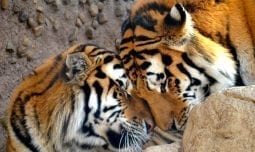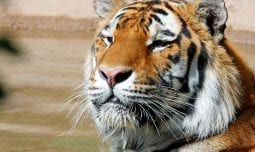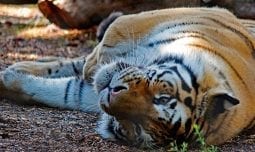Classification
Class Mammalia
Order Carnivora
Family Felidae
Genus Panthera
Species tigris
Subspecies altaica
Habitat & Range
Snow-covered deciduous, coniferous and scrub forests in the mountains.
The tiger’s traditional range is through southeastern Siberia, northeast China, the Russian Far East, and northern regions of North Korea.

Amur (Siberian) Tiger
Panthera tigris altaica
Tigers are the most boldly marked cats in the world. Their stripes and coloration provides the camouflage needed for a large predator in the wild. The pattern of stripes on a tigers face is as distinctive as human fingerprints – no two tigers have exactly the same stripe pattern.
Adaptations
The pattern of stripes on each tiger is unique, just like human fingerprints. Stripes may seem like they would stick out, but they help tigers stay hidden in dense forests when stalking prey
Along with the thick fur on their bodies they have an extra fur “scarf” around their necks. While all species of tigers have this Amur tigers have the most developed neck fur layer.
Extra fur on their paws acts like snow boots to protect them from the cold and snow. Tigers have large padded feet that enable them to silently stalk prey.
The claws of Amur tigers are up to 4 inches in length and are used to grasp and hold onto prey. Tiger claws are retractable. Tigers retract their claws to ensure that they remain sharp for catching prey. Tigers also use claws to communicate with each other. They create “scrapes” by raking the ground with the hind feet and leaving claw marks behind on trees.
Tigers have canine teeth that are 2.5-3 inches long– longer than any other predator. Powerful jaw muscles are attached to a bony ridge that lay on top of the skull called the sagittal crest. The larger the crest on a species the more muscles and more powerful the bite.
Physical Description
- Males are 9-12 feet (2.7-3.6 m) long including a two to three foot (60-90 cm) tail; females are up to 9 feet (2.7 m) long.
- Males weigh 400-700 pounds (180-315 kg); females weigh 220-370 pounds (99-166 kg).
- Reddish fur in the summer fading to yellowish color in winter with distinctive brown stripes. The belly fur is creamy white.
- Longer, thicker fur than other tiger species due to the harsh winter conditions in its habitat.
- Largest living cat in the world.
Diet
What Does It Eat?
In the wild: Large hoofed animals like roe deer, sika deer, goat, wild pig, sheep and sometimes domestic livestock.
At the zoo: Special feline diet and bones.
What Eats It?
Tiger cubs may occasionally be eaten by other predators. This animal is a predator at the top of its food chain.
Social Organization
Tigers live and hunt alone except for mating pairs or females with cubs.
Life Cycle
Female tigers are sexually mature at three to four years, males at four to five years. Mating most frequently occurs from November to April and a litter of two to four cubs is born after a gestation of 93-111 days. A female tiger raises her cubs alone. Cubs are born blind and helpless weighing one-and-a-half to three pounds (0.7-1.4 kg). They open their eyes at six to 14 days, nurse for three to six months and can travel with their mother by five to six months. They are taught to hunt by their mother and can hunt for themselves before they are a year old. By the time they are two years old, they can kill large prey on their own but they may stay with their mother for another year or more before leaving to establish their own territory. Half of all cubs do not survive the first two years. Amur tigers may live 15 years in the wild and 20-25 years in captivity.
Fun Facts
- A large tiger can consume up to 100 pounds of food at one time!
- Like housecats, tigers have long whiskers that are like “feelers” helping them find their way in the dark.
- A special reflective layer at the back of the eye called the “tapetum lucidum” increases the tigers’ night vision and also causes their eyes to shine in spotlights.
- Except for jaguars, tigers are the most aquatic of the big cats.
- Their large paws act like snowshoes to help them move through deep snow.
- The name of this cat is taken from the Amur region located along the Chinese-Russian border.
- Largest living cat in the world!
Conservation Status
IUCN Status: Critically Endangered
The remaining five subspecies of tiger are all endangered. It is estimated that only 350-450 Amur (Siberian) tigers remain in the wild although there are 650 in captivity. Tigers are poached for their bones and organs, which are prized for their use in traditional medicines. A single tiger can be worth over $15,000 – more than most poor people in the region can make in many years. In addition, forestry, mining and road construction are shrinking tiger habitat and range. Overhunting and habitat loss have also reduced the populations of prey animals the tigers depend on. Recent conservation efforts have increased the number of wild Siberian tigers but continued efforts will be needed to ensure their survival.

Download the App!
Get the FREE Denver Zoo app today, and be a pro the next time you visit the Zoo. You’ll get access to the Zoo map, daily activities and schedules, animal facts, and more. You can even load your membership card onto the app for additional convenience. It puts everything you need for an amazing Zoo experience right into the palm of your hand!






